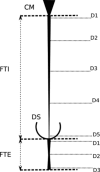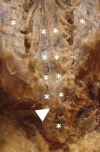Morphological analysis of the filum terminale and detailed description of the distal filum terminale externum: a cadaveric study
- PMID: 40201577
- PMCID: PMC11975916
- DOI: 10.3389/fnana.2025.1547165
Morphological analysis of the filum terminale and detailed description of the distal filum terminale externum: a cadaveric study
Abstract
This observational, descriptive anatomical cadaveric study aimed to identify, characterize, and analyze the morphometric parameters of the filum terminale (FT) and macroscopically describe the distal insertion of the FTE. The FT is a complex, three-dimensional, fibro-cellular structure of connective tissue and glial cells, extending from the conus medullaris (CM) to the dural sac (DS) and coccyx. It is divided into two segments: an intradural filum terminale internum (FTI) and extradural filum terminale externum (FTE). Few studies have comprehensively addressed its morphometric characteristics in the last decades. Thirty-eight embalmed (M = 16, F = 22) human cadavers were examined to determine the CM-FTI and DS-FTE vertebral levels and FT, FTI, and FTE lengths and widths. FTI and FTE segmental diameters, correlations, gross characteristics, tension, and mobility in situ and ex vivo were assessed. FTE distal insertion is thoroughly described. FT, FTI, and FTE mean lengths were 254.32 mm (±26.46), 152.75 mm (±22.02), and 106.64 mm (±12.21), respectively. The CM-FTI junction was observed at the L1-L2 disk space (32.1%), DS-FTE fusion in the upper third of S2 (39.3%), and FTI-DS fusion in the DS midline (46.4%). FT length and FTI, FTE lengths were directly correlated, as were all FTI diameters. FT gross characteristics were an irregular surface (71.4%), bright hue (57.1%), macroscopic FTI-CM contrast (64.3%), filiform shape (60.7%), and movement-resistance (53.6%). The FTE exhibited a flattened shape (64.3%), immobility (60.7%), distal insertion at Cx1 (67.8%) and one distal strand (60.7%). FTI segments ≥ 2 mm were uncommon (21.4%). The FTE distal insertion is variable, inserting as strands, with vascular tissue surrounding it. A distal coccygeal venous plexus and single or multiple strand-like insertions of the distal FTE are for the first time described in detail. Discrepancies in the morphometric parameters of the FT between studies highlight the need for standardized protocols, especially given the FT's anatomic-clinical importance and potential role as a neural progenitor niche. We provide a comprehensive basis for future standardized morphometric analyses, acknowledging the limitations of embalmed cadaveric studies.
Keywords: cadaveric study; conus medullaris; dura mater; dural sac; filum terminale; neuroanatomy; spinal cord; tethered cord syndrome.
Copyright © 2025 Buloz-Osorio, Ortega-Sánchez, Royo-Salvador and Rodríguez-Baeza.
Conflict of interest statement
The authors declare that the research was conducted in the absence of any commercial or financial relationships that could be construed as a potential conflict of interest.
Figures








Similar articles
-
The Filum Terminale: A Cadaver Study of Anatomy, Histology, and Elastic Properties.World Neurosurg. 2016 Jun;90:565-573.e1. doi: 10.1016/j.wneu.2015.12.103. Epub 2016 Jan 22. World Neurosurg. 2016. PMID: 26805693
-
Mechanical relationship of filum terminale externum and filum terminale internum: is it possible to detether the spinal cord extradurally?Childs Nerv Syst. 2018 Sep;34(9):1767-1770. doi: 10.1007/s00381-018-3837-3. Epub 2018 May 24. Childs Nerv Syst. 2018. PMID: 29797063
-
Morphometric parameters and histological study of the filum terminale of adult human cadavers and magnetic resonance images.Folia Morphol (Warsz). 2018;77(4):609-619. doi: 10.5603/FM.a2018.0041. Epub 2018 May 26. Folia Morphol (Warsz). 2018. PMID: 29802712
-
Spinal arteriovenous fistula located in the filum terminale externa: A case report and review of the literature.Interv Neuroradiol. 2021 Jun;27(3):451-455. doi: 10.1177/1591019920968363. Epub 2020 Oct 22. Interv Neuroradiol. 2021. PMID: 33092430 Free PMC article. Review.
-
Filum Terminale: A Comprehensive Review with Anatomical, Pathological, and Surgical Considerations.World Neurosurg. 2022 Aug;164:167-176. doi: 10.1016/j.wneu.2022.04.098. Epub 2022 Apr 30. World Neurosurg. 2022. PMID: 35500871 Review.
Cited by
-
Anatomical and histological characterization of the filum terminale in dogs.Front Vet Sci. 2025 Jul 24;12:1650893. doi: 10.3389/fvets.2025.1650893. eCollection 2025. Front Vet Sci. 2025. PMID: 40777825 Free PMC article.
-
Occult tethered cord syndrome: insights into clinical and MRI features, prognostic factors, and treatment outcomes in 30 dogs with confirmed or presumptive diagnosis.Front Vet Sci. 2025 Jul 11;12:1588538. doi: 10.3389/fvets.2025.1588538. eCollection 2025. Front Vet Sci. 2025. PMID: 40717908 Free PMC article.
References
LinkOut - more resources
Full Text Sources

